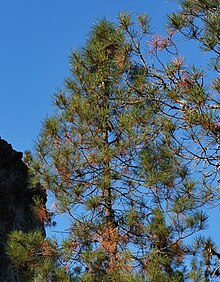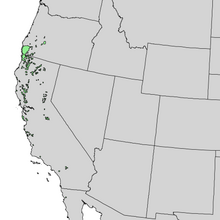Knobcone pine
| Knobcone pine | |
|---|---|

| |
| Scientific classification | |
| Kingdom: | Plantae |
| Clade: | Tracheophytes |
| Clade: | Gymnospermae |
| Division: | Pinophyta |
| Class: | Pinopsida |
| Order: | Pinales |
| Family: | Pinaceae |
| Genus: | Pinus |
| Subgenus: | P. subg. Pinus |
| Section: | P. sect. Trifoliae |
| Subsection: | P. subsect. Australes |
| Species: | P. attenuata
|
| Binomial name | |
| Pinus attenuata | |

| |
The knobcone pine, Pinus attenuata (also called Pinus tuberculata),[2] is a tree that grows in mild climates on poor soils. It ranges from the mountains of southern Oregon to Baja California with the greatest concentration in northern California and the Oregon-California border.[3]
Description
[edit]Individual specimens can live up to a century.[4] The crown is usually conical with a straight trunk. It reaches heights of 8–24 meters (26–79 feet),[5] but can be a shrub on especially poor sites. The bark is thin and smooth, flaky and gray-brown when young, becoming dark[4] gray-red-brown and shallowly furrowed into flat scaly ridges in age. The twigs are red-brown and often resinous. Its wood is knotty and of little interest for lumber.[4]
The leaves are in fascicles of three,[6] needle-like, yellow-green, twisted, and 9–15 centimeters (3+1⁄2–6 in) long. The cones are resin-sealed and irregularly shaped,[4] 8–16 cm (3+1⁄4–6+1⁄4 in) long and clustered in whorls of three to six on the branches. The scales end in a short stout prickle. Cones can sometimes be found attached to the trunk and larger branches.[4]
-
Leaves
-
male cones
-
Cones
-
Knobcone pine cone
-
Plant
-
Habitat
Distribution
[edit]The knobcone pine can be found growing in the dry, rocky soils of southern Oregon and northern California, between 300 and 750 m (980 and 2,460 ft) above sea level.[4] It forms nearly pure stands, preferring to grow where there is no competition.[4]
Ecology
[edit]On the coast, the knobcone pine may hybridize with bishop pine (Pinus muricata), and Monterey pine (Pinus radiata).
In the western foothills of the Sierra Nevada, knobcone pine is often a co-dominant with blue oak (Quercus douglasii).[7]
The species is susceptible to fire, but this melts the cone resin, releasing seeds for regrowth.[4] The species seems to be shade intolerant.[4]
See also
[edit]References
[edit]- ^ Farjon, A. (2013). "Pinus attenuata". IUCN Red List of Threatened Species. 2013: e.T42343A2974092. doi:10.2305/IUCN.UK.2013-1.RLTS.T42343A2974092.en. Retrieved 12 November 2021.
- ^ Chase, J. Smeaton (1911). "Pinus tuberculata, Also called P. attenuta (Knob-cone-pine, Scrub-pine)". Cone-bearing Trees of the California Mountains. Eytel, Carl (illustrations). Chicago: A.C. McClurg & Co. pp. 32–34. LCCN 11004975. OCLC 3477527.
- ^ Moore, Gerry; Kershner, Bruce; Craig Tufts; Daniel Mathews; Gil Nelson; Spellenberg, Richard; Thieret, John W.; Terry Purinton; Block, Andrew (2008). National Wildlife Federation Field Guide to Trees of North America. New York: Sterling. p. 85. ISBN 978-1-4027-3875-3.
- ^ a b c d e f g h i Arno, Stephen F.; Hammerly, Ramona P. (2020) [1977]. Northwest Trees: Identifying & Understanding the Region's Native Trees (field guide ed.). Seattle: Mountaineers Books. pp. 58–61. ISBN 978-1-68051-329-5. OCLC 1141235469.
- ^ Earle, Christopher J., ed. (2018). "Pinus attenuata". The Gymnosperm Database.
- ^ eNature Field Guides (2007) Knobcone Pine
- ^ Hogan, C. Michael (2008). Blue Oak: Quercus douglasii, GlobalTwitcher.com, ed. Nicklas Stromberg
Further reading
[edit]- Bakker, Elna S. (1971). An island called California. University of California press (1972). ISBN 0-520-02159-2







